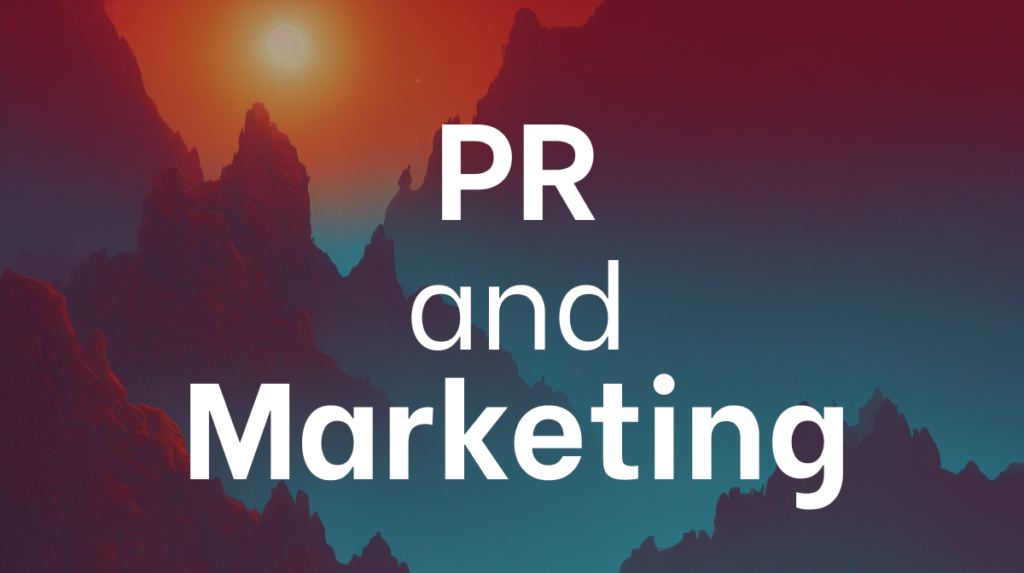Are you struggling to make PR and Marketing work together in harmony? Do you feel like you’re constantly having to pick one over the other?
The truth is, they don’t have to be mutually exclusive. With the right strategy, PR and marketing can work together to create a more powerful and effective message that reaches a broader audience.
In this blog post, we’ll explore how PR and marketing can be used in tandem to achieve greater success. We’ll cover topics such as the differences between PR and marketing, understanding your target market, developing a strategy that works for both departments, and more. With this knowledge, you should be able to craft an effective plan of action that will maximize the power of both disciplines.
What Is PR?

Public Relations (PR) is a form of communication and storytelling that typically involves crafting messaging and campaigns to help shape or manage your organization or product’s public image. It often involves leveraging the media, including traditional and digital/social platforms, to tell stories and deliver news to the people you are trying to convince and influence—whether they are consumers, prospects, investors, influencers, or other companies.
By building relationships with journalists and generating interest in your brand through press coverage, public relations allows you to reach larger audiences than traditional advertising tactics. Instead of buying an ad in a magazine or website, PR works with journalists to feature content about your company or products in relevant publications. This helps position your company as an authority on the subject matter.
Finally, PR professionals often focus on helping companies mitigate potential risks by maintaining a positive reputation and addressing any negative publicity when it arises. By establishing relationships with key stakeholders in the media, as well as influencers in relevant industries, PR professionals can help proactively respond to developing stories about the company before they become full-fledged controversies.
What Is Marketing?
Marketing is one of the most essential pieces in a company’s puzzle. It is an overall plan that identifies who your target customer is, how you can reach them, and how to keep them engaged. Think of it as a combination of tools, tasks, and strategies that together allow you to reach your target audience and achieve your desired results.
Some of the tasks associated with marketing include creating campaigns, tracking performance metrics, developing messaging, creating content such as blog posts and videos, engaging in social media activities, running paid advertising campaigns, relying on SEO for search engine optimization, and measuring results to ensure success.
In short: Marketing provides an effective way to reach your target customers and establish relationships that convert into sales. When marketing is done correctly and consistently with thoughtful strategy in place, it can result in long-term relationships that build brand loyalty and help your business prosper.
How and Why PR & Marketing Work Together

PR and marketing are a powerful combination when it comes to driving success. By working together, you can leverage the strengths of both disciplines to create an effective brand image.
When done right, combining PR and marketing can elevate your brand’s visibility and credibility, as well as boost its reputation. PR can help tell your story in a meaningful way that resonates with audiences, and marketing can amplify this story through more traditional channels like radio, television, and print advertising.
Here are some of the ways these two disciplines work together:
-PR can create stories that cut through the chaos of a crowded marketplace.
-Marketing takes these stories and ensures they reach the right people at the right time.
-PR can build relationships with key influencers in your industry or target audience.
-Marketing helps to ensure that any content or campaigns are seen by the right people across multiple channels.
-Both PR and marketing work together to define clear objectives and goals for campaigns.
-PR helps to establish credibility while marketing is able to capture the attention of a wider audience with targeted messaging.
By executing both disciplines simultaneously, you will be able to maximize your efforts and reach more potential customers – creating a win-win situation for everyone involved!
Establishing a Clear Company Narrative
When it comes to PR and marketing, one of the most important things to do is to establish a clear and unified company narrative. This is the story that you want to tell people about your business and its values.
This narrative should be conveyed both through your marketing materials, as well as through any communication with the media, whether it’s a press release or an interview. This ensures that all stakeholders are on the same page and have a thorough understanding of what you stand for.
Creating an effective message requires careful planning and precise execution. When crafting your narrative, consider the following:
- Identify the main story – What makes your company unique?
- Understand your target audience – Who are you trying to reach?
- Incorporate key messages – What core values will be communicated?
- Establish impactful visuals – How can you use visuals to enhance your message?
- Utilize multiple channels – How can you reach customers across various platforms?
By establishing a unified company narrative that connects PR and marketing, you can create a strong presence for yourself in both traditional and digital channels alike.
Crafting an Effective Message

When crafting a message to promote your brand, it’s important for PR and marketing to work together. PR helps you identify key messages that will resonate with your target audience, while marketing works to amplify those messages so that you can reach a broader audience.
It’s also beneficial to have both PR and marketing working on the same message, so that they are in agreement on the core messaging points. This helps ensure that all communications efforts are being used to paint a consistent brand image and tell a cohesive story. Here are some strategies to help you craft an effective message:
- Establish objectives – Set SMART goals for what you want your message to accomplish
- Build relationships – Reach out to industry influencers or media outlets who can help spread your message
- Analyze data – Monitor industry trends and analytics to develop messages for targeted audiences
- Choose the right channels – Use popular channels like social media, email, or video conferencing platforms to ensure maximum visibility
- Track performance – Evaluate metrics from channels used in order to gage messaging effectiveness
With both PR and marketing working together, you can craft an effective messaging strategy that reaches the right people with the right information at the right time.
Leveraging Content Across Both Platforms

Having both PR and marketing working together means that you can produce high-quality content to engage customers across multiple platforms. Every piece of content should have a goal in mind, such as increasing brand awareness or generating more sales. This is where the power of both PR and marketing come together.
Marketing can provide the tools to help promote the content created, such as advertising and social media campaigns, while PR can help reach new audiences with targeted outreach activities or thought leadership pieces. By joining forces, you are able to widen your reach and ensure your content is seen by the right people.
Leveraging content across both platforms also helps to increase brand visibility and trust. By creating consistent messaging and visuals across platforms, customers will recognize your brand more easily, making them more likely to engage with it.
In addition, PR and marketing can work together to measure the success of each campaign. With tools like Google Analytics, marketers can track website visits, conversion rates, keyword searches, and other metrics that help measure the impact of their campaigns. By measuring these metrics together, it’s easier for teams to evaluate their success rates and create strategies for future campaigns.
Conclusion
Establishing successful communication between the PR and marketing teams is key to ensure that the brand message is well-crafted, strategic, and tailored to the right audience. By harmoniously working together, both departments can help to effectively drive sales, maintain market visibility and foster customer loyalty. Moreover, when used in tandem, they can provide an unbeatable combination of proactive and reactive prowess, making it possible to effectively tackle any challenge that arises. Taking the time to understand the different strategies, goals, and approaches of both the PR and marketing teams will help to ensure seamless collaboration and positive outcomes for the brand.

